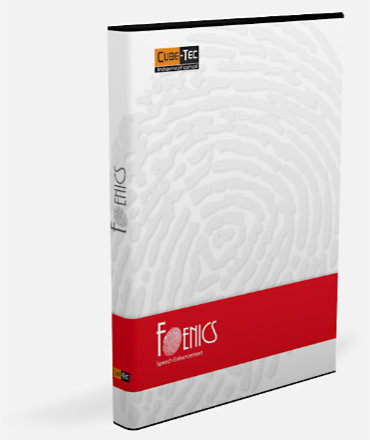
Foenics (forensic audio)
Störungen in einer Audiodatei wie Rauschen, Brummen, Artefakte und einzelne verzerrte Frequenzen können einfach und automatisiert mit den Werkzeugen von FOENICS entfernt werden. Der Forensiker ist durch die leistungsstarken Analysetools und deren Zoomfunktionen ebenfalls in der Lage, jeden Teil der ursprünglichen oder verarbeiteten Signale im Frequenzbereich zu betrachten. Spezielle Tools zum Entfernen schwieriger Burst-Signale (z.B. GSM Burst von Handy-Aufnahmen) oder Clipping sind ebenfalls verfügbar.

Hauptfunktionen
- Modularer Ansatz zur forensischen Audiorestaurierung
- Einfach zu bedienen, insbesondere durch automatische Signalanalysen
- Komplett portabel - kann auf jedem Laptop oder PC verwendet werden
- Unterstützte Betriebssysteme: Windows XP bis einschließlich Windows 10
- Umfassende Dateiunterstützung durch Steinbergs WaveLab Editor
In Depth
The field of forensic speech and audio analysis comprises a wide range of activities like speaker identification, speech enhancement or examination of the authenticity of audio recordings. Unfortunately, the forensic expert often has to cope with heavily distorted audio recordings. In these cases a forensic analysis is often impossible or adequate analysis tools are not available until now. For this reason Cube-Tec has developed the restoration and analysis suite Foenics specialized for forensic purposes.
The Foenics Software was developed in close co-operation with the Bavarian State Criminal Office to produce a custom made solution for forensic audio and speech analysis experts. The combination of years of experience in the field of professional audio restoration and state-of-the-art technology has finally paid off to produce this expert range of forensic tools. Foenics is based on the powerful Steinberg Wavelab sound editor and contains different Foenics Precision Instruments (FPIs) for almost all restoration and analysis cases. It is possible to freely cascade different FPIs leading to a perfect adaptation of every restoration or analysis problem. The Foenics Software Package contains the complete range of modules needed by forensics experts to restore distorted audio signals used for speaker identification, speech enhancement and examination of the authenticity of recordings.
Two FPIs for the analysis of the frequency domain are:
- SonaView visualizes the spectrogram of the audio recording to be analyzed.
- SpectraView views the power spectral density of a signal in any desired frequency and amplitude range.
Furthermore, the Foenics Software contains several enhancement FPIs to improve the signal quality, intelligibility and audibility:
- Artefact-Removal frees the signal being processed from artefacts like crackles or non-linear distortions.
- Buzz-Removal eliminates hum and buzz distortions.
- FrequencyBand-Removal is a freely scaleable, artefact-free high-slope filter.
- Frequency-Removal contains eight independent and completely adjustable notch filters.
- Noise-Removal is a freely scaleable high performance denoiser.
For special enhancement problems, additional FPIs can be utilised:
- Burst-Removal is the first satisfying tool available for the removal of burst distortions like induced GSM-bursts.
- Clip-Removal recovers the loss of peak signals caused by digital clipping.
Foenics 2.0
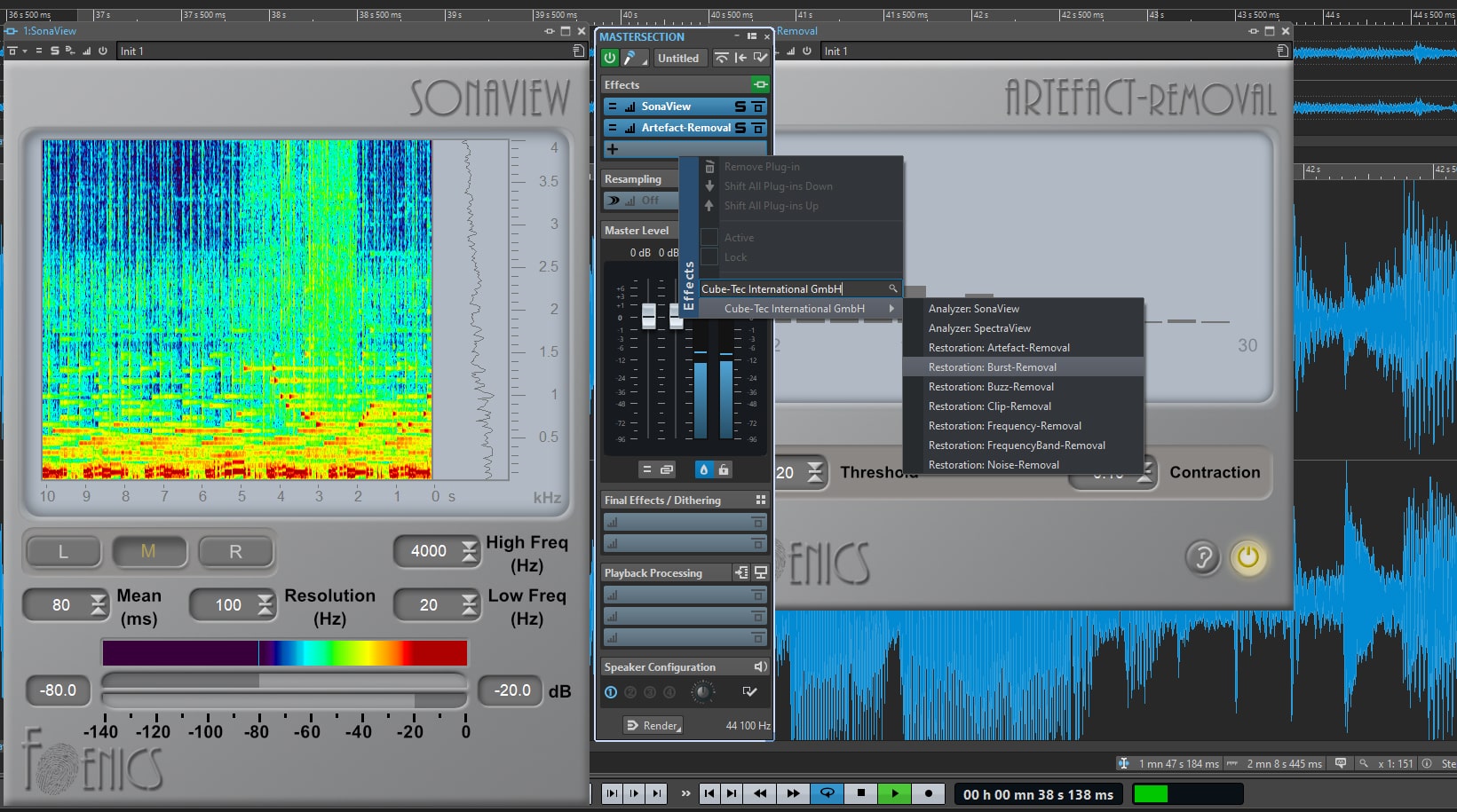
New in version 2
- Improved functionality and efficiency - Enlarged graphical user interfaces - Full 64-bit processingFoenics Precision Instruments
| SonaView: | Visualizes the spectral content of a signal |
| SpectraView: | Offers the ability to view a specific section of the spectrum |
| Artefact-Removal: | Can remove almost all kinds of artefacts degrading the intelligibility of a speech recording |
| Buzz-Removal: | Optimized for the removal of intelligibility and audibility, reducing humming and buzzing noises |
| FrequenzyBand-Removal: | An advanced filtering tool providing all common used filter characteristics |
| Frequency-Removal: | A highly efficient tool for the precise attenuation of small frequency bands, and can be used to remove constant tones and other artefacts. |
| Noise-Removal: | A specialized denoising tool for forensic purposes |
| Burst-Removal: | Eliminates large burst degradations such as induced GSM-bursts |
| Clip-Removal: | Recovers and reconstructs digitally clipped passages |
Analyze FPIs
SonaView

The SonaView FPI visualizes the spectral content of a signal. It can be used for the identification of special disruptions in speech signals with persistent frequencies, for example, hum.
When applying this FPI, it is easy to detect frequency characteristics of a specific speaker in speech signals, which is currently one of the main problems in the forensic area of operations. The frequency range of the spectrogram can be varied, i.e. the operator can zoom-in on specific parts of interest to get a closer look. The timescale is extended to display ten seconds of the signal. This allows a very detailed analysis of the signal for forensic purposes.
Three values (frequency, amount and time) of the current mouse position in the display are shown. The signal levels are represented by an adjustable range of colors which help to emphasize certain ranges of the spectrum.
In the case of a stereo recording, the user can view the spectra-range of both channels, or switch between the left and right channel (cancellation effects caused by phase inverted channels).
SpectraView
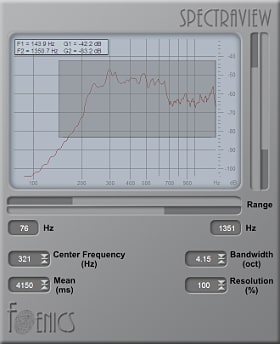
SpectraView offers the ability to view a specific section of the spectrum. The frequency and level axes are freely scaleable to any desired resolution.
The viewable bandwidth can be defined using the mouse, by manually setting the values for the lowest and the highest frequency shown in the display, or the middle frequency and bandwidth.
If the needed information is contained in a very low frequency range, a special option is available to optimize the display for this bandwidth - a great tool for forensic processing.
The user has the ability to move forwards and backwards through each display parameter change during a session. Along with the ability of returning to a full frequency range with a single mouse-click, this makes the SpectraView a powerful and efficient forensic analysis tool indeed.
Removal FPIs
Artefact-Removal
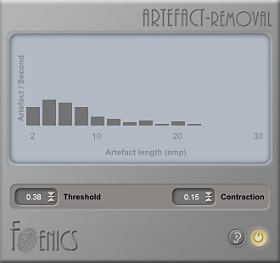
Artefact-Removal can remove almost all kinds of artefacts degrading the intelligibility of a speech recording. It is very easy to handle, because the implemented adaptive algorithms will do "the job" automatically.
The user only has to adjust two parameters manually - the sensitivity of the artefact removal is adjusted by the 'Threshold' parameter, and the 'Contraction' parameter sets the amount of removed artefacts. This offers the possibility to enhance the intelligibility and listenability without affecting the desired signal.
The adjustments of the user parameters are simplified by the display of the number and length of eliminated artefacts. The ability to listen either to the removed or restored signal offers great advantages for the forensic analyst. This function could be used in real-time for an optimal parameter adjustment, or as an analysis of the artefacts.
Buzz-Removal
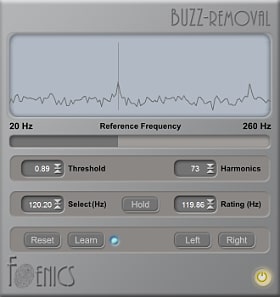
Buzz-Removal is optimized for the removal of intelligibility and audibility, reducing humming and buzzing noises.
The frequency range between 20 and 260 Hz is shown in a high resolution display, allowing a fast manual detection of the fundamental frequency of the disturbance.
If the user wishes to use the Buzz-Removal FPI in its automatic mode, the signal is analyzed and the fundamental frequency of the distortion is detected. Depending on this frequency, a complete batch of harmonically related filters is calculated. The user can define the number of filters that are used. The underlying adaptive algorithm eliminates the corresponding number of mostly dominating intelligibility reducing harmonics. Buzz-Removal FPI also allows the processing of signals with a frequency varying buzz distortion. These frequency changes are handled automatically using the frequency tracking function, without further adjustments by the forensic analyst.
FrequenzyBand-Removal
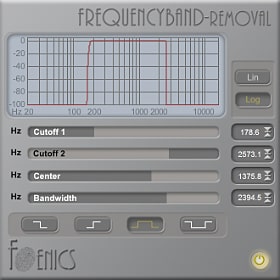
FrequencyBand-Removal is an advanced filtering tool providing all common used filter characteristics. It can be applied as a high slope lowpass, highpass, bandstop or bandpass filter, with a stopband attenuation of 100 dB.
Because of its intuitive handling, the forensic analyst is able to remove unwanted frequency bands with an amazing accuracy simply by choosing the filter characteristic and the corresponding frequencies.
A great advantage of the FrequencyBand-Removal related to the forensic casework is the fact that the authenticity of the signal is not affected by any resonance artefacts.
Frequency-Removal
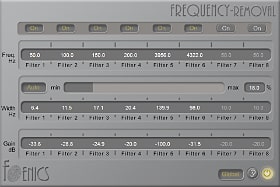
The Frequency-Removal FPI is a highly efficient tool for the precise attenuation of small frequency bands, and can be used to remove constant tones and other artefacts.
Eight independent high quality notch filters are implemented, and can easily be used by choosing the center frequency, bandwidth and the desired attenuation. The ability to listen to the removed signal passages in real-time allows easy adjustments, and ensures the maximal signal integrity retained by avoiding the elimination of uncorrupted 'information' by the forensic analyst.
A further simplification of the adjustments can be achieved by using the Frequency-Removal 'Auto' mode, defining the recommended bandwidth automatically.
Noise-Removal
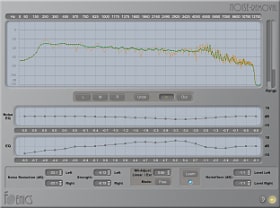
Noise-Removal FPI is a specialized denoising tool for forensic purposes. It employs highly efficient 'fingerprinting' techniques whereby it is no longer necessary to search for a section of the recording where the noise is evident, as necessary with other systems. This is very important in the forensic casework because even complex material can be denoised to enhance the signals intelligibility. The Noise-Removal FPI offers a lot of new opportunities to the analyst.
To be able to achieve best results, the estimated fingerprint of the noise floor is freely scaleable in the frequency domain. Additionally, the noise floor is adjustable in the psychoacoustically optimized Bark scale to alter the filter characteristic of the denoising process. These characteristics can be optimized by using perceptually weighted curves and a free scaleable strength of the denoising.
An important feature is the ability to equalize the processed signal without affecting the residual noise. This allows the amplification of important frequency ranges containing the desired information (e.g. speech components) and to attenuate other areas (e.g. high and low frequency distortions). Based on this high performance algorithms it is possible to reduce the noise floor up to 40dB without generating artefacts like 'musical tones'.
The adjustments are simplified by the display of the input or output spectra of the signal, the corresponding noise floor estimation, and the ability to listen to the removed part of the signal in real-time. Using this feature, the forensic analyst can ensure that no information is lost.
Specialist FPIs
Burst-Removal
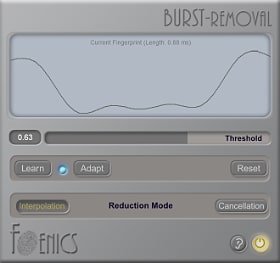
Burst-Removal eliminates large burst degradations such as induced GSM-bursts, by using its adaptive algorithms. The Burst-Removal FPI cancels these bursts without affecting the rest of the audio material. In the case of an overload caused by the burst, the underlying signal will be heavily damaged, and the intelligibility of this part is drastically reduced. For this purpose the Burst-Removal FPI offers an interpolation mode which removes the burst distortion and restores the degraded signal.
The user has only to choose a single burst for detection. Based on this user-defined distortion, all other disturbed parts of the signal will be detected and restored automatically. The level at which the interpolation or cancellation begins can be adjusted with a single 'Threshold' control. The output can be auditioned, allowing the user to listen to the eliminated bursts. This function can be used in real-time for an optimal parameter adjustment or as a distortion analysis.
Clip-Removal
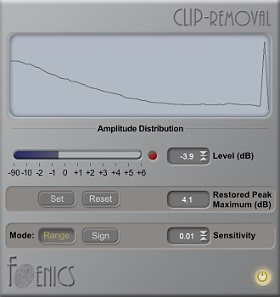
Digital clipping is a severe problem for the restoration of signals, especially in the forensics context, since subsequent restoration steps and reasonable forensic analyses are otherwise impossible.
The Clip-Removal FPI recovers and reconstructs all kinds of digitally clipped passages using adaptive algorithms, regardless of whether a full-scale signal amplitude is reached or not. The original dynamic range of the signal is reconstructed, and the square wave characteristic distortion components are completely removed.
This process is very important for a forensic analysis, e.g. identification of a fundamental frequency and its harmonics. Additionally, when the passages are automatically adjusted, this is shown in the display, making manual adjustments much simpler.
System Requirements
FOENICS modules are built for Windows PCs or Laptops.
- 64bit Windows Operating System
- 64bit VST Host Application (latest WaveLab Pro version recommended)
Sound Example
Example 1
Example 2
Example 3
Example 4
Cube-Tec International will continuously develop new FPI technologies to offer new optimized solutions for any forensic speech enhancement or analysis problem."

